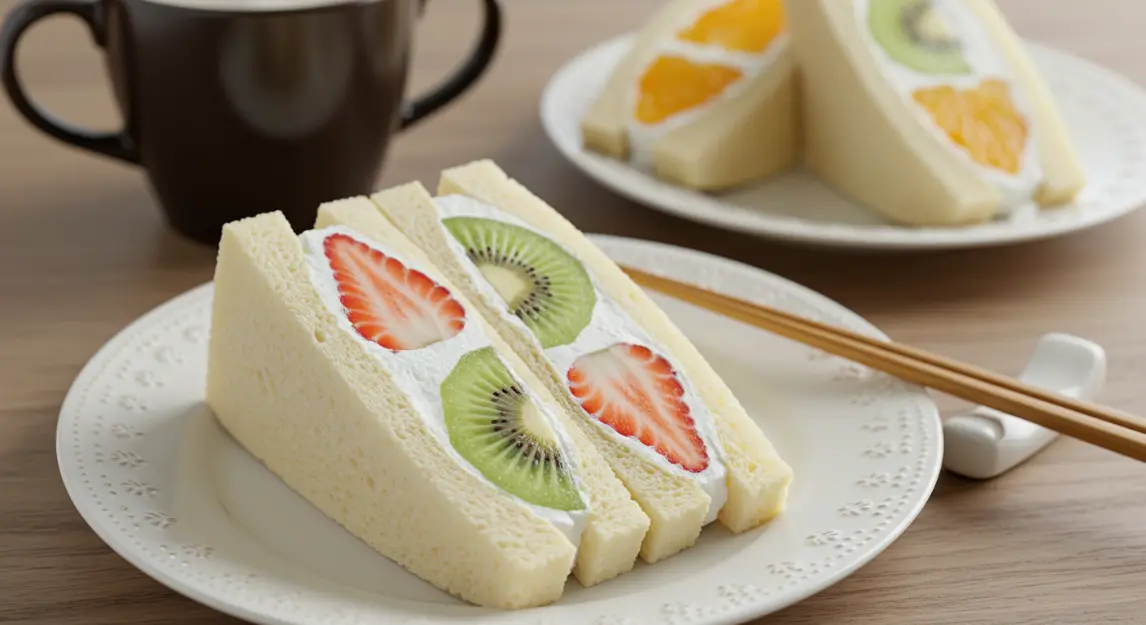The fruit sando is a very popular dish in Japan. It is a sandwich filled with whipped cream and fruit! The arrangement of the fruit is critical, as it must be aligned to showcase the look of the fruit once the sandwich is cut.
The fruit sando: a simple but effective recipe.
Anyone can easily access the ingredients that make up fruit sandos. Slices of white bread, whipping cream, and fruit! Nothing could be simpler! Even making the dish is easy and quick! That said, it’s the resting time in the refrigerator that will work its magic to elevate the dish! Indeed, the aroma of the fruit and the moisture from the cream will have time to spread to the bread, giving it a softer side. The cool temperature of the dish also adds an additional pleasant aspect!
The result is a fragrant and fresh experience in your mouth that is sure to delight you! In addition to being very beautiful, you will enjoy a quick and economical treat.
Tips for making your sando successfully.
There are a few steps that are critical to successfully making your sando.
The first is to pat your fruit dry, because excess water will make the whipped cream too liquid. We don’t want our sando to be dripping everywhere. We want it to hold together well.
The second aspect to watch for is the arrangement of the fruit in order to know how to cut the sando and offer the best view of the fruit once the sandwich is cut. Put a little whipped cream in your sando. This will create a base to stabilize your fruit. Align your fruit in the sandwich so that it is centered in the same orientation. Add cream around your fruit and top it all off with an additional layer of cream on top. Place the last slice of bread on top.
The trick here is to keep your sandwich at the same angle in order to remember the orientation of the fruit. When you have wrapped your sando in plastic wrap, make sure to always keep the sandwich in the same orientation. Once wrapped in the film, you can draw with a marker the angle in which you will need to cut the sando on the film. Refrigerate and once rested, all you have to do is cut your sando along the line.
Getting the Whipped Cream Right.

For a fruit sando, you need a whipped cream that’s much firmer than the usual soft, airy kind. A standard whipped filling can’t support the weight of the fruit and bread, risks turning grainy if over-whipped, and has a one-dimensional flavor.
The solution is to add mascarpone cheese to the cream. This common baking technique uses the thickness of the mascarpone to stabilize the filling, making it sturdy and melt-resistant. It also adds a richer, more complex dairy flavor. The final task was simply to determine the perfect ratio of mascarpone to cream for the best stability and taste.
I mixed equal amounts of heavy cream and mascarpone together and whipped them at medium speed until they got thick and fluffy. This was a bad way to blend the cheese. Mascarpone is thicker than heavy cream, so it needs more time to get fluffy. The mixture looked like whipped cream at first, but when I looked closer, there were still lumps of mascarpone. When I tried to mix them together at the same time, I couldn’t make the mascarpone smooth without beating the heavy cream too much. To get a smooth, creamy texture, you need to whisk the mascarpone by itself first, then add the heavy cream.
Regarding proportions, the 1:1 ratio proved overly decadent. Though undeniably tasty, the blend favored mascarpone over cream, not quite what I was after. A 4:1 cream-to-mascarpone ratio rendered the cheese nearly imperceptible; I could scarcely detect its presence, and the texture remained stubbornly similar to ordinary whipped cream. The optimal combination, as it turned out, was 2:1 cream to mascarpone, yielding a sturdy yet light, mousse-like consistency that struck the perfect balance. Beyond the standard whipped cream enhancements, vanilla extract and powdered sugar. I incorporated a pinch of salt. Even desserts benefit from thoughtful seasoning, which amplifies flavor and helps ingredients taste more authentically themselves.
Selecting the Ideal Sando Fruit
The strawberry-and-cream pairing remains unmatched, making it my preferred fruit sando variety, though this shouldn’t discourage culinary exploration. Seek out fruits that offer sweetness while maintaining enough acidity to balance the cream’s richness, kiwis and mangoes excel in this regard. The perfect fruit should yield slightly to pressure while retaining enough structure for clean bites. (Bananas represent the lone exception to the sweet-tart principle, after all, who could resist banana cream pie reimagined as a sandwich?)
While citrus fruits occasionally appear in recipes, adequately containing tangerines or clementine’s without creating a messy, juice-laden disaster proves challenging, making them inadvisable choices. Generally speaking, watery and excessively juicy options like watermelon and pineapple should be avoided. Crisp fruits such as apples, despite their standalone appeal, possess too much firmness for a delicate sandwich constructed from fluffy milk bread and billowy whipped cream.
Below you’ll discover guidance for creating variations using kiwis, mangoes, and bananas with this recipe. Like the main instructions, these directions yield two sandwiches.
For kiwi fruit sandos: Remove the skin from four kiwis using a vegetable peeler. Cut each kiwi in half along its length and set the pieces aside. With an offset spatula, apply roughly 3 tablespoons of whipped cream to every bread slice. Place the 4 kiwi halves cut-side down on one bread slice, positioning them at angles to create an X pattern.
For mango fruit sandos: Peel the mango with a vegetable peeler. Remove both cheeks from the pit and reserve them. Using an offset spatula, coat each bread slice with approximately 3 tablespoons of the whipped cream mixture. Position one mango cheek cut-side down on a bread slice, then top with the second slice.
For banana fruit sandos: Remove the banana peel and cut the fruit in half widthwise. Slice the banana crosswise once more into 2-inch pieces and set them aside. With an offset spatula, distribute about 3 tablespoons of whipped cream mixture across each bread slice. Arrange the banana pieces cut-side down on one slice, then complete the sandwich with the remaining bread.
Proper Fruit Sando Slicing Technique
Slicing a fruit sando often becomes a messy endeavor, though proper chilling keeps the chaos to a minimum. Regardless of whether you intend to consume the sandwiches right away, wrapping them securely in plastic wrap, applying firm pressure to compress the bread, and chilling them for no less than an hour before cutting remains essential. (While nothing prevents you from slicing and enjoying a fruit sando immediately after assembly, I must warn you that this approach guarantees a spectacularly messy outcome.).
Pressing down lightly on the sandwich spreads the cream evenly by pushing it into any little spots your spatula might have missed, and it helps the fruit and cream stick together better. I like to use a marker to draw right on the plastic wrap where I want to cut so I can show off the fruit slices nicely.
The colder your sandwich is, the easier it’ll be to cut without making a mess. For the cleanest cuts, grab a serrated knife and use a gentle back-and-forth sawing motion. Wipe off your knife between sandwiches and don’t just push straight down, that’ll squish the bread edges and make all the filling squeeze out.
Printfruit sando
- Total Time: 1 hour 20 minutes
- Yield: 2 sandwiches 1x
- Diet: Vegetarian
Description
Japanese fruit sandos featuring fluffy whipped mascarpone cream, fresh strawberries, and soft milk bread for a delightful sweet sandwich treat.
Ingredients
- 1/2 cup mascarpone (about 4 ounces; 120g)
- 1 cup (240ml) heavy cream
- 2 tablespoons (14g) powdered sugar
- 1/4 teaspoon vanilla extract
- Pinch kosher salt
- 4 slices shokupan, homemade or store-bought
- 8 to 10 medium strawberries (1 to 2 inches wide), hulled, or assorted pieces of cut fruit
Instructions
- In the bowl of a stand mixer fitted with the whisk attachment, whisk mascarpone on medium speed until smooth, about 1 minute. Add heavy cream, powdered sugar, vanilla extract, salt, and whip on medium speed until stiff peaks form, 3 to 4 minutes. Do not over whip; over whipped cream will be grainy.
- Place slices of shokupan on a clean cutting board and, using an offset spatula, spread 3 tablespoons of whipped cream mixture onto each slice of bread. To build one sandwich, place 4 to 5 strawberries on their sides onto 1 slice of bread, arranging them in a “X” pattern that runs corner to corner. Cover with a second slice of bread, cream-side down, press very gently to adhere, and being careful not to squish the whipped cream filling out the sides, wrap tightly with plastic wrap. Using a Sharpie, mark where you plan to cut the sandwich in order to reveal the cut sides of the fruit. Repeat with remaining bread and strawberries.
- Refrigerate until cream has chilled and sandwich is firm when pressed gently, about 1 hour.
- When ready to serve, remove plastic wrap and place sandwiches on cutting board. Using a serrated knife and using a steady back and forth sawing motion, carefully remove crusts and cut sandwiches in half diagonally, slicing strawberries in half. Serve immediately.
Notes
- Use a 2:1 ratio of heavy cream to mascarpone for best texture
- Whisk mascarpone alone first before adding cream to avoid lumps
- Chill sandwiches for at least 1 hour before cutting for cleanest slices
- Use a serrated knife with sawing motion, avoid pressing straight down
- Can substitute strawberries with kiwis, mangoes, or bananas
- Shokupan is Japanese milk bread, available at Asian grocery stores
- Prep Time: 20 minutes
- Cook Time: 0 minutes
- Category: Dessert
- Method: No-Bake
- Cuisine: Japanese
Nutrition
- Serving Size: 1 sandwich
- Calories: 420
- Sugar: 18g
- Sodium: 180mg
- Fat: 32g
- Saturated Fat: 20g
- Unsaturated Fat: 10g
- Trans Fat: 0g
- Carbohydrates: 28g
- Fiber: 2g
- Protein: 8g
- Cholesterol: 95mg
Keywords: fruit sando, Japanese sandwich, strawberry sandwich, whipped cream, mascarpone, shokupan, milk bread, no-bake dessert

